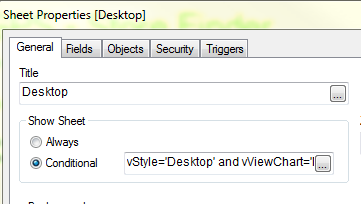Unlock a world of possibilities! Login now and discover the exclusive benefits awaiting you.
- Subscribe to RSS Feed
- Mark as New
- Mark as Read
- Bookmark
- Subscribe
- Printer Friendly Page
- Report Inappropriate Content
In my last blog I explained how, using conditional expressions, a developer could enhance the experience of a user. And based on some feedback, I have decided to continue the discussion of conditional expressions. In this blog, I want to discuss another area within QlikView where a developer can use conditional expressions to his/her advantage.
Using Conditional Expressions to Show/Hide Sheets
There are times when, as developers, we need to tailor the user experience based on a device (i.e. Desktop vs Mobile). In the GPS – Store Finder app on demo.qlik.com, we do just that. Based on the values of conditional expressions on the sheet properties, we can give the user a more desired experience.
The version of the app on the demo site uses a mobiledetect extension that checks to see through which device type the user is accessing the application. It then sets a variable (vStyle) to either Mobile or Desktop.
The app also uses non-traditional navigation by hiding the Tabrow.

Setting the conditional show sheet expression to only show when the variable vStyle=’Mobile’ hides the sheets designed for the Desktop and allows the user to experience the Mobile version of the app.

Mobile Version
This is set up to fit nicely on a mobile phone with a vertical scroll and larger fonts to assist in better navigation.

Conversely, setting the conditional show sheet expression to only show when the variable vStyle=’Desktop’ hides the sheet designed for Mobile and allows the user to experience the Desktop version of the app.

Desktop version
Designed with a more traditional approach with the list boxes on the left and the viewing area set within the 1024x768 screen resolution.

By taking advantage of the conditional expression for a sheet, we were able to customize the user experience and, in essence, create one application to handle multiple client types. Another example of the use of conditional expressions to show/hide sheets based in device is the Insurance Demo which can also be found on demo.qlik.com.
You must be a registered user to add a comment. If you've already registered, sign in. Otherwise, register and sign in.